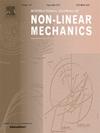Nonlinear vibration analysis of a fluid-conveying pipe under harmonic excitation with elastic boundary constraints
IF 2.8
3区 工程技术
Q2 MECHANICS
International Journal of Non-Linear Mechanics
Pub Date : 2024-12-31
DOI:10.1016/j.ijnonlinmec.2024.104981
引用次数: 0
Abstract
Fluid-conveying pipes are extensively used in practical engineering in various industries and play an important role in industry and daily life. Under complicated working conditions, inevitable vibrations affect the stability and integrity of these pipes, drawing significant academic attention. Typically, the dynamic modeling of these pipes considers ideal rigid boundary conditions, including fixed support, simply support, and cantilever pipes, ignoring the effects of boundary elasticity. This paper investigates the effects of boundary elasticity on the harmonic excitation responses in sub-critical and super-critical regimes. The governing equations and boundary conditions are derived via the extended Hamilton's principle. Later, the non-trivial equilibrium configuration is analytically deduced, and the governing equations for fluid-conveying pipes with elastic supports are discretized into a set of nonlinear ordinary differential equations using the Galerkin method. The harmonic balance method (HBM) is employed to solve these differential equations, with its accuracy validated against the Runge-Kutta method. Finally, numerical examples are conducted in sub-critical and super-critical regimes to show the effects of boundary vertical stiffness, torsional stiffness, fluid velocity, and excitation on solution stability, natural frequencies, and amplitude of the steady-state response at the middle point. This paper provides important guidance for the design of boundary elasticity in sub-critical and sup-critical fluid-conveying pipes.
求助全文
约1分钟内获得全文
求助全文
来源期刊
CiteScore
5.50
自引率
9.40%
发文量
192
审稿时长
67 days
期刊介绍:
The International Journal of Non-Linear Mechanics provides a specific medium for dissemination of high-quality research results in the various areas of theoretical, applied, and experimental mechanics of solids, fluids, structures, and systems where the phenomena are inherently non-linear.
The journal brings together original results in non-linear problems in elasticity, plasticity, dynamics, vibrations, wave-propagation, rheology, fluid-structure interaction systems, stability, biomechanics, micro- and nano-structures, materials, metamaterials, and in other diverse areas.
Papers may be analytical, computational or experimental in nature. Treatments of non-linear differential equations wherein solutions and properties of solutions are emphasized but physical aspects are not adequately relevant, will not be considered for possible publication. Both deterministic and stochastic approaches are fostered. Contributions pertaining to both established and emerging fields are encouraged.

 求助内容:
求助内容: 应助结果提醒方式:
应助结果提醒方式:


